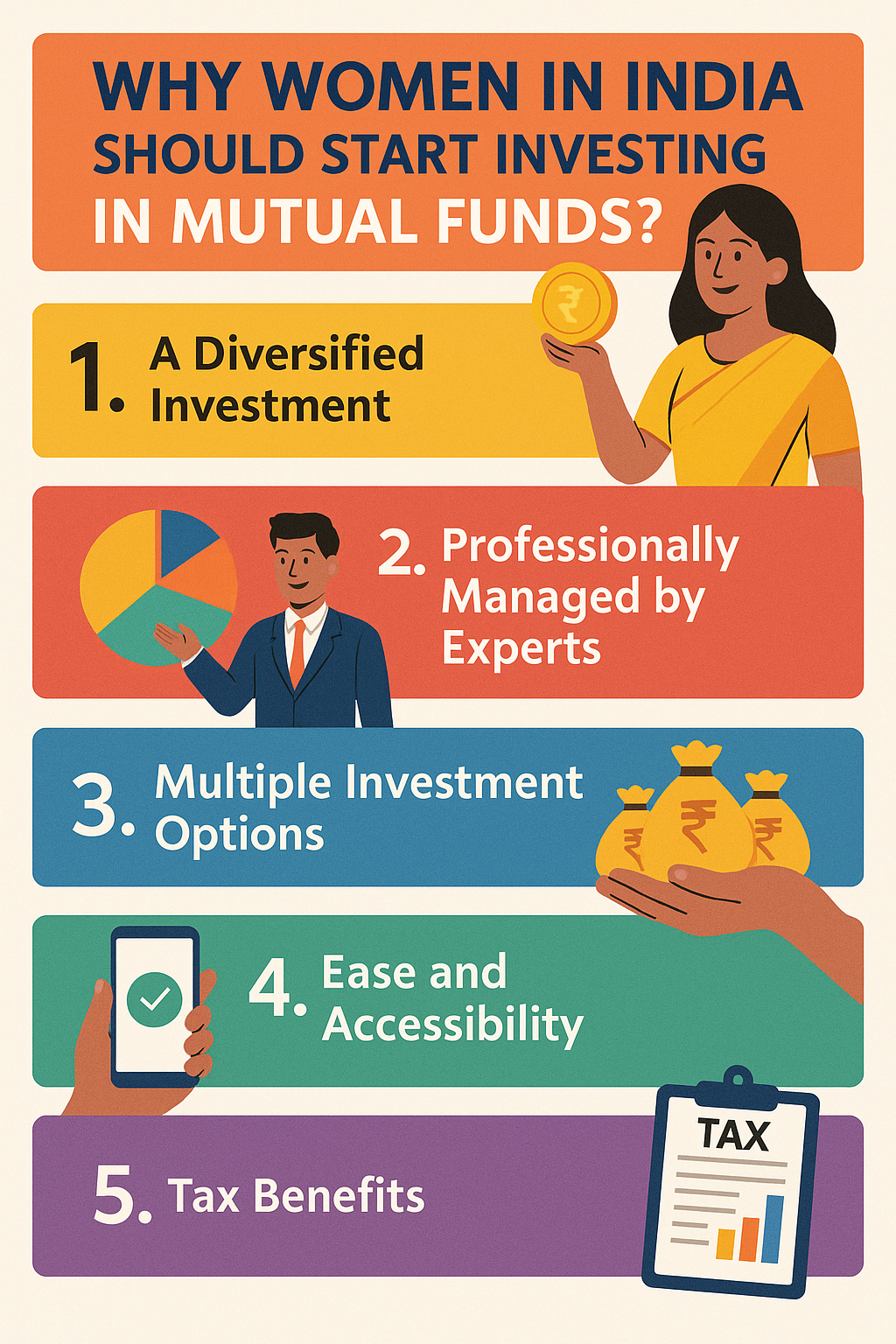Why Women in India Should Start Investing in Mutual Funds?
1. A Diversified Investment
Mutual funds pool money into diverse assets like equities, bonds, bullion, and other instruments across multiple sectors. This diversification helps reduce risk and achieve balanced and stable returns, ideal for long-term financial goals.
2. Professionally Managed by Experts
Experienced fund managers continuously monitor market trends, reshuffling portfolios to optimize returns and mitigate risks. Different fund types are managed by specialists in equity, debt, or hybrid instruments, giving women access to strategic, data-driven investing.
3. Multiple Investment Options
Women can choose from:
-
Equity Funds (for higher returns and high-risk appetite)
-
Debt Funds (for stable, low-risk investing)
-
Hybrid Funds (balanced options)
-
Open-ended & Closed-ended Funds
-
ELSS (Equity Linked Savings Scheme) for tax savings
4. Ease and Accessibility
Investments can begin with as little as ₹500 through SIPs. Women can choose to invest regularly or make lump-sum contributions as per convenience. Open-ended schemes offer flexibility to enter/exit, while closed-ended funds suit one-time investments.
5. Tax Benefits
Investing in ELSS funds offers deductions up to ₹1.5 lakh under Section 80C. Though LTCG tax applies to profits over ₹1 lakh annually at 10%, these funds help reduce overall taxable income.

In recent years, Indian women have emerged as a powerful force in mutual fund investing—today, one in every four investors is a woman, with their collective assets under management more than doubling from ₹4.59 lakh crore in March 2019 to ₹11.25 lakh crore by March 2024. They now represent about ₹33 of every ₹100 invested in mutual funds.
What’s even more notable is the shift in investment behavior—women are holding funds longer, increasing their average folio size by 23%, favoring SIPs, and making 22% higher SIP contributions and 45% larger lump sums compared to men. This is not just about financial participation—it reflects empowerment, independence, and smart money management.
Mutual funds offer diversification, professional management, flexibility, and long-term growth, making them an ideal avenue for women to safeguard against income disruptions, combat the gender pay gap, and build lasting wealth.
Women Investors in Mutual Funds
As of March 2025, women account for 25.7% of mutual fund investors in India, up from 24.2% the previous year. Their assets under management have more than doubled in five years, highlighting a growing confidence in market-linked investments.
Here are some key trends:
-
21.3% of women’s AUM is held for over 5 years (up from 8.8% in 2019)
-
SIP AUM from women surged 319% between 2019 and 2024
-
Average folio size grew 23–24%, vs. 5–6% growth in men’s folios
-
Equity fund allocation rose from 43.3% to 63.7%
-
Debt fund exposure declined from 22.6% to 10.7%
-
Gold ETFs now form 24.9% of women’s AUM
-
Direct plan investments grew from 14.2% to 20.3%
These trends signal not only rising participation but also maturity in investment strategies.
How Should Women Start Investing in Mutual Funds?
Whether working professionals or homemakers, women can begin investing by following a simple plan:
1. Define Your Investment Goals
Are you investing for education, marriage, buying a home, emergencies, or wealth creation? Set clear goals to decide how much to invest and for how long.
2. Assess Risk Tolerance
If you’re risk-averse, choose debt or hybrid funds. If you’re open to higher risk for better returns, go for equity or ELSS funds.
3. Choose the Right Fund House
Research past 3–5 year performances of fund houses. Use fund comparison tools or check consistency in returns to select the most suitable fund house and schemes.
4. Start with a SIP or Lump Sum
-
Working women can begin with a SIP of ₹500 or more, aligned with monthly income.
-
Homemakers may consider lump sum investments in low-risk funds from saved funds or family income.
5. Consult a Financial Adviser
If unsure, consult a SEBI-registered investment adviser (RIA) to match your risk profile and financial goals with the right mutual fund strategy.
6. Monitor and Rebalance
Keep an eye on your investments. Markets change, and regular reviews help rebalance portfolios for optimal returns and aligned risk exposure.
Conclusion
Women in India are breaking financial barriers and embracing mutual funds like never before. With increasing access to digital platforms, awareness, and financial education, mutual funds provide the right mix of flexibility, returns, and control, empowering women to take charge of their financial futures.
By starting early, staying consistent, and choosing the right strategies, women can unlock the full potential of mutual fund investing and build a secure, independent, and prosperous tomorrow.
![]()



